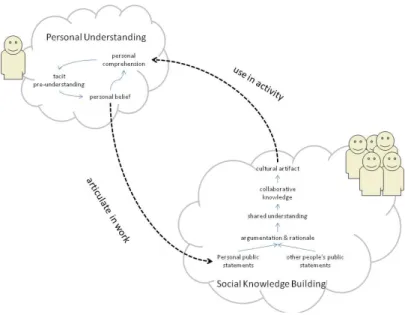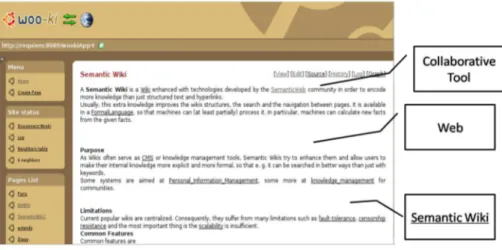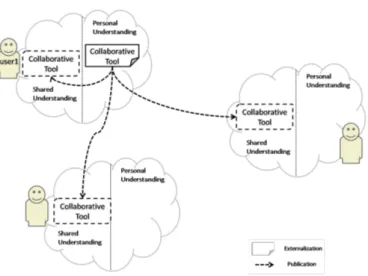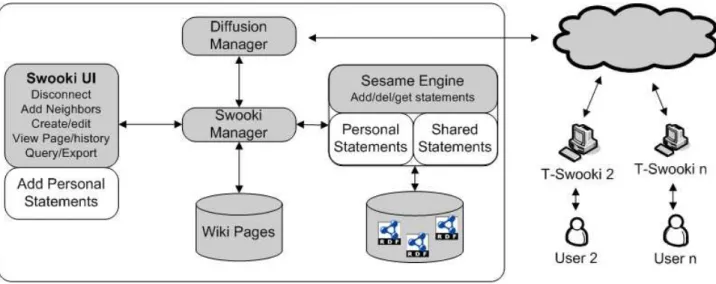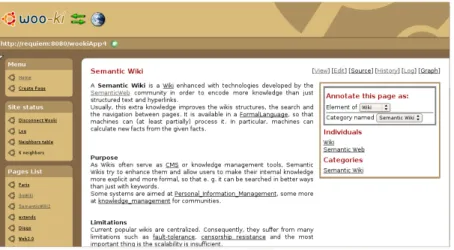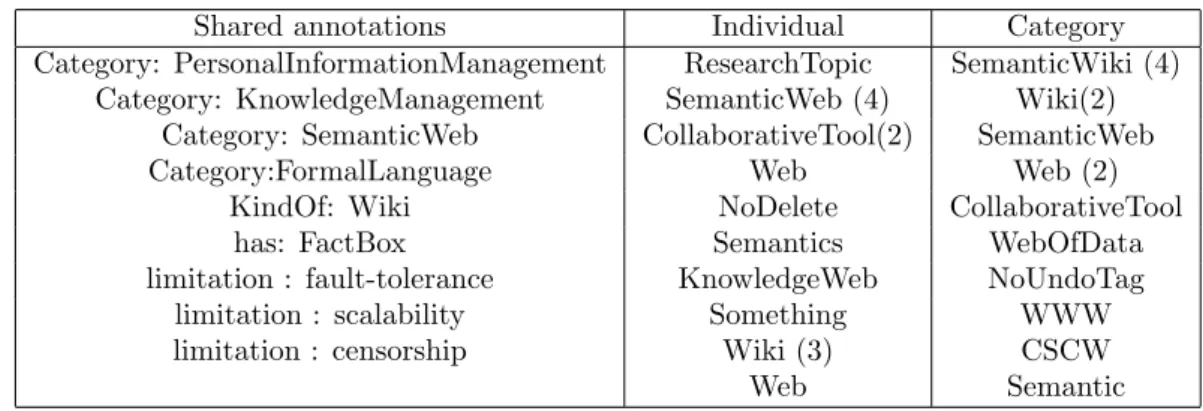HAL Id: inria-00348628
https://hal.inria.fr/inria-00348628
Submitted on 19 Dec 2008
HAL is a multi-disciplinary open access
archive for the deposit and dissemination of
sci-entific research documents, whether they are
pub-lished or not. The documents may come from
teaching and research institutions in France or
abroad, or from public or private research centers.
L’archive ouverte pluridisciplinaire HAL, est
destinée au dépôt et à la diffusion de documents
scientifiques de niveau recherche, publiés ou non,
émanant des établissements d’enseignement et de
recherche français ou étrangers, des laboratoires
publics ou privés.
Personal and Shared Knowledge Building in P2P
Semantic Wikis
Diego Torres, Hala Skaf-Molli, Alicia Dias, Pascal Molli
To cite this version:
Diego Torres, Hala Skaf-Molli, Alicia Dias, Pascal Molli. Personal and Shared Knowledge Building in
P2P Semantic Wikis. [Research Report] RR-6783, INRIA. 2008, pp.16. �inria-00348628�
a p p o r t
d e r e c h e r c h e
ISSN 0249-6399 ISRN INRIA/RR--6783--FR+ENG Thème COGINSTITUT NATIONAL DE RECHERCHE EN INFORMATIQUE ET EN AUTOMATIQUE
Personal and Shared Knowledge Building in P2P
Semantic Wikis
Diego Torres — Hala Skaf-Molli — Alicia Diaz — Pascal Molli
N° 6783
Unité de recherche INRIA Lorraine
LORIA, Technopôle de Nancy-Brabois, Campus scientifique, 615, rue du Jardin Botanique, BP 101, 54602 Villers-Lès-Nancy (France)
Téléphone : +33 3 83 59 30 00 — Télécopie : +33 3 83 27 83 19
Personal and Shared Knowledge Building in P2P Semantic Wikis
Diego Torres
∗, Hala Skaf-Molli
†, Alicia Diaz
‡, Pascal Molli
§Th`eme COG — Syst`emes cognitifs Projet ECOO
Rapport de recherche n° 6783 — October 08 — 13 pages
Abstract: In this paper, we propose to extend Peer-to-Peer Semantic Wikis with personal semantic annota-tions. Semantic Wikis are one of the most successful Semantic Web applicaannota-tions. In semantic wikis, wikis pages are annotated with semantic data to facilitate the navigation, information retrieving and ontology emerging. Semantic data represents the shared knowledge base which describes the common understanding of the commu-nity. However, in a collaborative knowledge building process the knowledge is basically created by individuals who are involved in a social process. Therefore, it is fundamental to support personal knowledge building in a differentiated way. Currently there are no available semantic wikis that support both personal and shared understandings. In order to overcome this problem, we propose a P2P collaborative knowledge building process and extend semantic wikis with personal annotations facilities to express personal understanding. In this paper, we detail the personal semantic annotation model and show its implementation in P2P semantic wikis. We also detail an evaluation study which shows that personal annotations demand less cognitive efforts than semantic data and are very useful to enrich the shared knowledge base.
Key-words: P2P, Semantic Wikis, Personal Knowledge, Shared Knowledge
∗diego.torres@lifia.info.unlp.edu.ar LIFIA, Facultad de Inform´atica, Universidad Nacional de La Plata, Argentina † Skaf@loria.fr, ECOO Project, Nancy-University, LORIA, INRIA Centre - Nancy Grand Est
‡ alicia.diaz@lifia.info.unlp.edu.ar, LIFIA, Facultad de Inform´atica, Universidad Nacional de La Plata, Argentina § molli@loria.fr, ECOO Project, Nancy-University, LORIA, INRIA Centre - Nancy Grand Est
Construction collaborative des connaissances dans les wikis
s´
emantiques pair-`
a-pair
R´esum´e : Dans ce papier, nous proposons d’´etendre les wikis s´emantiques avec des annotations s´emantiques personnelles. Nous d´etaillons notre mod´ele d’annotations et nous montrons son implementation dans un wiki s´emantique P2P. Nous d´etaillons aussi une ´exprimentation qui montre l’importance de ces annotations. Mots-cl´es : Pair-`a-pair, Wikis s´emantiques, Connaissance Individuelle, Connaissance Partag´ee
Personal and Shared Knowledge Building in P2P Semantic Wikis 3
Contents
1 Introduction 4
2 Background : Collaborative Knowledge Building 4 3 P2P Collaborative Knowledge Building Approach 5
3.1 P2P Collaborative Knowledge Building Process . . . 6
3.2 Personal Semantic Annotations: Individuals and Categories . . . 6
4 P-Swooki: P2P Collaborative Knowledge Building System 7 4.1 Shared semantic annotation management . . . 7
4.2 Personal semantic annotations management . . . 7
4.3 P-Swooki Data Model . . . 8
4.4 Personal semantic annotation storage model . . . 8
4.5 Editing operations . . . 8
5 P-Swooki Architecture 9 6 Evaluation 10 6.1 Results . . . 10
7 Conclusion and Further work 12
8 Acknowledgments 12
4 Torres,Skaf-Molli, Diaz& Molli
1
Introduction
Semantic Wikis [1, 2, 3, 4] are one of the most successful Semantic Web applications. They are widely used for collaborative knowledge building. In semantic wikis [1, 3], wikis pages are annotated with semantic data to facilitate the navigation, the information retrieving and ontology emerging. Semantic data represents the shared knowledge base which describes the common understanding of the community. The knowledge base is built collaboratively through an iterative and social process.
However, knowledge is basically created by individuals [5] and it is fundamental to support personal knowl-edge building [6]. Personal Semantic Wikis [6, 7] provide an easy way to manage personal knowlknowl-edge often without collaborative functionality. However, to carry out a collaborative knowledge building activity, user needs to manage and combine both shared and personal knowledge. Collaborative knowledge building [8, 9] is a spiraled process which involves externalization, publication, internalization and reaction.
Existing collaborative knowledge building systems support partially or completely this process. For instance, [10, 11, 12] are collaborative knowledge building systems, however, they are more oriented towards collaborative ontology development rather than ontology emerging. Other systems like semantic wikis [1, 2, 3, 4, 6] are more appropriate to support collaborative knowledge emerging, however, they do not provide functionalities to manage combined personal and shared understandings. For example, Semantic MediaWiki (SMW) only enables shared knowledge building. On the other hand, SemperWiki [7] only supports personal knowledge building. Currently, there are no semantic wikis that help people to combine and manage in a usable way both kind of knowledge.
The goal of this work is to propose an innovative semantic wiki approach that supports both personal and shared knowledge building. In this approach, the shared knowledge is unique and accessible to everyone, while the personal knowledge is only accessible by its owner and represents the user private view (perspective) of the shared one. Personal knowledge can differ from the shared one, but it can also have overlapped parts.
For the emerging of shared knowledge, we follow the same approach as SMW where shared semantic
anno-tations are embedded in the wiki text by using a suitable syntaxis. For the personal knowledge, we propose Personal Semantic Annotations to externalize personal understanding. Personal semantic annotations are
as-sociated to the wiki page and they are only accessed by the owner user. For the end-user, the personal semantic
annotations look like tags, however they are semantically richer: they support categories and individuals.
We believe that the addition of Personal Semantic Annotations to semantic wikis enables: • To support the individual understanding in the collaborative knowledge building process [9] • To provide personalized knowledge retrieving, structuring and navigation.
• To enable a combined personal and shared knowledge retrieving.
• To enrich the shared semantic annotations and to augment, therefore, the shared knowledge base. Moreover, adding personal semantic annotations and shared ones involve complementary activities. While adding a shared semantic annotation seems to be suitable during editing activity, adding a personal one seems to be more suitable during browsing activity. In order to validate these hypothesis, we have conducted an evaluation study.
In this paper, we introduce a peer to peer semantic wiki called P-Swooki that supports both personal and shared knowledge building. P-Swooki extends a peer-to-peer semantic wiki Swooki [3] by adding personal knowl-edge building. We choice to validate our approach in a peer to peer semantic wiki because in a P2P architecture information dissemination is easily controlled i.e. shared annotations are broadcasted and integrated by the all peers while personal semantic annotations remain local.
The paper is organized as follows. The next section 2 gives a brief background about collaborative knowledge building process. The section 3 introduces a P2P collaborative knowledge building process and discusses the personal annotations problematic. Sections 4 and 5 present the implementation and architecture of P-Swooki. Section 6 details a usage study which shows that personal annotations demand less cognitive efforts than shared one and they are very useful to enrich the shared knowledge base. The last section concludes the paper and points further works.
2
Background : Collaborative Knowledge Building
The majority of works on knowledge management focus on organizational knowledge management [13, 14]. Many of them follow the traditional KM approach [5] to creates large centralized knowledge repositories, in which corporate knowledge is collected, represented and organized, according to a single - shared - conceptual schema [15]. In [16], the authors noted that ”This centralized approach -and its underling objectivist
epistemology-is one of the reasons why so many KM systems are deserted by users”. In [13, 16] , the authors propose a
Personal and Shared Knowledge Building in P2P Semantic Wikis 5 P2P organizational knowledge management in order to make organizational memory more flexible. However, this approach is more suitable to knowledge discovery and propagation rather than collaborative and personal knowledge building.
Collaborative knowledge building focus on understanding as a learning process where personal understanding can not be built internally without social interaction. People need to participate in a social process and create new knowledge collaboratively. Gerry Stahl in [9] proposes a conceptual collaborative knowledge building model which shows the ”mutual constitution of the individual and the social knowledge building as a learning process”, as depicted in the figure 1. This process should be adapted to the P2P semantic wikis context.
Stahl’s process starts with the description of the personal understanding by specifying personal beliefs, which are tacit. Then, they can be articulated in a ”language” and enters into a social process of interaction with other people and their shared understanding. Later, this shared knowledge enters again in the personal understanding and provokes a change in personal beliefs, motivations and concerns. When this happens, these modifications become a new tacit understanding and will be the new starting point for future understanding and further learning. A simplified version of this process has been proposed in [8]. The authors proposed four steps spiral process for centralized knowledge sharing.
• knowledge externalization where knowledge goes from tacit to explicit. This is an individual activity. • Knowledge publication where the knowledge goes from individual context to share context. This produces a new shared knowledge contribution.
• Knowledge internalization where knowledge goes from explicit to tacit and from shared to individual context
• Reaction is the act of opening a discussion and argumentation linked to previous shared contribution to achieve a consensus. A reaction always involves a externalizations and an eventual publication.
In this work, we will adapt the simplified version of Stahl’s process to the context of P2P semantic wikis.
Figure 1: Stahl’s Collaborative Knowledge Building Process
3
P2P Collaborative Knowledge Building Approach
In this work, we extend P2P semantic wikis by supporting personal understanding building. In addition to shared semantic annotations embedded in the wiki text, users can also associate personal semantic annotations to semantic wiki pages. These private annotations express personal understanding of the users. For example, if a user was navigating to the semantic wiki page ”Semantic Wiki” as it is shown in the figure 2, eventually, she would like to annotate this page as ”Collaborative Tool”, ”Web” and ”Semantic Wiki”. If these annotations only express personal understanding, they should be private. Other annotations as ”Semantic Web” or ”Wiki” are shared, they may be were defined by the same user or by other users. We can notice that users manage simultaneously both shared and personal semantic annotations.
We adapt the collaborative knowledge building process to P2P settings as it is detailed in the next section.
6 Torres,Skaf-Molli, Diaz& Molli
Figure 2: Adding Personal Semantic Annotation in Semantic Wiki
3.1
P2P Collaborative Knowledge Building Process
A P2P collaborative knowledge building process is a continuous spiraled process which involves externalization,
publication, internalization and reaction, where externalization and publications steps had to be redefined to
support P2P settings. Internalization and Reactions are not modified.
Besides, users manage in a well-differentiated way both, personal and shared understandings. Every user needs to manage in a separated spaces the personal and shared annotations. We define two repositories: the
personal understanding repository and the shared understanding repository respectively. In a P2P setting, we
consider that every user works in one peer and have both repositories. The shared understanding repositories will be eventually identical for all users thanks to the synchronization algorithms [17].
Our P2P collaborative knowledge building process redefines the externalization and publications steps as: • Externalization where personal knowledge goes from tacit to explicit. Users use personal semantic anno-tations to externalize their own knowledge. This is an individual activity, this knowledge remains private in the context of the personal understanding space.
• Publication where the knowledge goes from individual context to share one. As a result, a personal semantic annotation becomes a shared semantic one. In other words, this involves to move a personal semantic annotation from a particular user’s personal understanding repository to the shared one of every user.
For example, in the figure 3 the ”user1” externalizes ”Collaborative Tool” personal annotation on her personal repository. Then, when she performs a publication this personal annotation should be disseminated to every user, even to herself. After publication, the semantic annotation ”Collaborative Tool” should appear in every shared understanding repository as a shared annotation.
Consequently, personal understanding building is achieved by supporting the separation of both knowledge repositories (personal and shared) and the externalization step.
This P2P collaborative knowledge building approach has several advantages:
• Personal navigation: the system allows users to have simultaneously personal and shared navigation on the the same content. Shared navigation is the traditional navigation supported by any semantic wiki. Personal navigation is a new kind of navigation, it is personal and it is the consequence of the personal semantic annotations. The user has an instant gratification after adding personal semantic annotations.
• Enrichment of shared knowledge : the user can make public her personal semantic annotations. Conse-quently, shared knowledge are enriched.
• Improve system usability: adding shared semantic annotations and personal semantic ones involve com-plementary activities. While adding shared semantic annotations seems to be suitable during editing activity, adding personal one seems to be more suitable during reading activity.
3.2
Personal Semantic Annotations: Individuals and Categories
Every semantic wiki page could be tagged with several personal semantic annotations as it was shown above. A personal semantic annotation can be a category or an individual.
Personal and Shared Knowledge Building in P2P Semantic Wikis 7
Figure 3: P2P Collaborative Knowledge Building Process
Categories define a family of elements. For example, in previous example (figure 2), the annotation ”Semantic
Wiki” was underlined in order to indicate that this wiki page play the role of the Semantic Wiki category
definition.
Individuals denote elements that falls at least in one category. Semantic Mediawiki is an individual that fall
in the category Semantic Wiki. An Individual can belongs to many categories.
A semantic wiki page can be annotated with many annotations. For example, a user would like to personally annotate the wiki page ”Swooki” as a ”Semantic Wiki” and as ”P2P application”.
For instant, the annotation model is simple, it only considers categories and individuals. In the near future, we will enrich it in order to support relationships and attributes.
4
P-Swooki: P2P Collaborative Knowledge Building System
We have developed P-Swooki, a P2P collaborative knowledge building system that extends the P2P semantic wiki Swooki with personal semantic annotations.
Shared semantic annotations are already supported by Swooki as detailed in the section 4.1. Therefore, we had only to add personal annotations functionalities to Swooki. In sections 4.2, 4.3 and 4.5, we detail the personal annotations management, the data model and its associated operations.
4.1
Shared semantic annotation management
In Swooki every peer hosts a copy of all wiki pages and the shared understanding repository. When a peer updates its local copy of data, it generates a corresponding operation. This operation is processed in four steps:
1. It is executed immediately against the local replica of the peer, 2. it is broadcasted through the P2P network to all other peers, 3. It is received by the other peers,
4. it is integrated to their local replica. If needed, the integration process merges this modification with concurrent ones, generated either locally or received from a remote server.
To synchronize data, Swooki [18] implements a modified version of the P2P synchronization algorithm detailed in [17]. Swooki synchronization algorithm ensures the convergence on the wiki text and the shared
understanding repository i.e. when the system is idle, all copies are identical.
4.2
Personal semantic annotations management
In P-Swooki, personal semantic annotations are hosted locally. When a user updates her personal semantic annotations, she generates a corresponding operation. The operation is executed locally against the user personal
understanding repository. This operation is not broadcasted to other peers.
The process to annotate a wiki page is simple as it was explained above. The system enables users to annotate a wiki page as a new category or as an individual of an existing category.
8 Torres,Skaf-Molli, Diaz& Molli
In order to handle personal semantic annotations, we extended Swooki’s data model and defined new editing operations.
4.3
P-Swooki Data Model
The data model is an extension of Swooki [18, 19] data model. Therefore, every semantic wiki peer has assigned a global unique identifier named N odeID.
As in any wiki system, the basic element is a wiki page, therefore every wiki page has assigned a unique identifier P ageID, which is the name of the page. The name is set at the creation of the page. If several servers create concurrently pages with the same name, their content will be directly merged by the synchronization algorithm. Notice that a U RI can be used to unambiguously identify the concept described in the page. The U RI must be global and location independent in order to ensure load balancing. For simplicity, in this paper, we use a string as page identifier.
The figure 4 describes the personal semantic annotations data model. This data model is described by the the Ontology Definition Meta-model (ODM) [20].
Figure 4: Personal Semantic Annotation Data Model
4.4
Personal semantic annotation storage model
RDF is the standard data model for encoding semantic data. In P-Swooki, every peer has two local RDF repos-itories : Personal Statements and Shared Statements. They implement the personal understanding repository and the shared understanding repository respectively.
• The Shared Statements contains a set of RDF statements extracted from the wikis pages. A statement is defined as a triple (Subject, Predicate, Object) where the subject is the name of the page, the predicates (or properties) and the objects are related to the concept involved in the page.
• The Personal Statements contains personal semantic annotations which are represented as personal RDF statements. A personal RDF statement is defined as a triple (Subject, Predicate, Object) where the subject is the wiki page and the predicate annotates the page as a personal semantic annotation type as described in the next section.
We define two operations on the RDF repositories:
• insertRDF(R,t): adds a statement t to the Personal Statements or Shared Statements repository R. • deleteRDF(R,t): deletes a statement t from the Personal Statements or Shared Statements repository R. These operations are not manipulated directly by the end user, they are called implicitly by the editing operations as it is shown in the following section.
4.5
Editing operations
There are four editing operations for editing personal semantic annotations: addIndividual, addCategory,
delIn-dividual and delCategory. An update is considered as a delete of old value followed by an insert of a new
value.
1. addCategory(P ageID, CategoryN ame) : where P ageID is the identifier of the semantic wiki page. CategoryN ameis the name of the new category.
Personal and Shared Knowledge Building in P2P Semantic Wikis 9 This operation sets the wiki page P ageId as a category in the user personal repository. This operation calls the insertRDF(Personal Statements,(P ageId, RDF.Type, CategoryN ame)) function to add a new triplet into the personal RDF repository.
2. addIndividual(P ageID, CategoryN ame) : sets the wiki page P ageID as a member of the category CategoryN ame. If CategoryN ame does not exist, it is added automatically to the Personal Statements repos-itory by calling the operation addCategory and then the operation annotate the P ageId as member of the CategoryN ame.
During this operation an RDF statement is added to the personal repository by calling insertRDF(Personal
Statements, (P ageId, belongsTo, CategoryN ame)) where belongsT o is a predicate to associate an individual
to a category.
3. delIndividual(P ageID, CategoryN ame: eliminates the P ageID as member of the category CategoryN ame from the personal RDF repository by calling DeleteRDF(Personal Statements, (P ageId, RDF.Type, CategoryN ame)).
4. delCategory(P ageID,CategoryN ame : first call the dellIndividual operation for each member of the category CategoryN ame, and then deletes the category CategoryN ame from the personal RDF repository by calling DeleteRDF operation.
5
P-Swooki
Architecture
P-Swooki is implemented as an extension of Swooki. Swooki is a P2P semantic wiki which is implemented in
Java as servlets in a Tomcat Server and uses Sesame 2.0 as RDF repository.
P-Swooki is developed over a Swooki architecture using one peer per user. A P-Swooki peer is compound by the following components (see figure 5). The grey boxes are Swooki components while white ones are the P-Swooki components.
User Interface. The P-Swooki UI component is composed by the Swooki wiki editor and it incorporates the functionalities to make personal annotations. This basically divides the wiki page into two areas: the shared and private annotation spaces. The shared space is defined by a regular wiki editor supported by Swooki functionality. The private annotation one includes a box to add personal semantic annotations and to visualize them (see figure 6).
Swooki Manager.The Swooki manager implements the synchronizing algorithm.
Sesame Engine.We use Sesame 2.0 [21] as RDF repository. Sesame is controlled by the Swooki manager for storing and retrieving RDF statements. P-Swooki stores the private annotations using a different name space. This allows to reuse the storing and retrieving facilities already implemented by Swooki.
Diffusion Manager.The diffusion manager is in charge to maintain the membership of the unstructured network and to implement a reliable broadcast for the shared repositories.
Figure 5: P-Swooki Architecture
10 Torres,Skaf-Molli, Diaz& Molli
Figure 6: P-Swooki Interface
6
Evaluation
In this section, we present the evaluation of our approach. We have conducted two separate experiences, one in France and another in Argentina. The total number of participants were 15 persons. The participants ranged in age from 25 to 45. All participants were involved in computer science, all were familiar with wikis and 5 of them were familiar with semantic wikis and have some experience in ontology building. The participants were in different rooms and they were not allowed to communicate to each other during the experience.
We started the first experience in France by a short explanation about semantic wikis, shared knowledge and personal knowledge. We asked participants to use a special syntax in order to control vocabulary explosion as it occurs in folksonomies [22]. The users did not start with an empty semantic wikis. In fact, we have created in advance 2 semantic wikis pages. One about Semantic Wiki and the another about Semantic Web.
In order to consolidate the first experience, we have repeated the same experience in Argentina which confirmed the obtained results in France. These experiences show a preliminary evidence of the contribution of our approach. In the following we show the results of these experiences. As both experiences showed the same result, we only details French results.
6.1
Results
In this section, we present the results of our preliminary evaluation regarding the usability of personal semantic annotations and their complementarity with the shared knowledge.
The table 1 and 2 show the type and the quantity of the personal semantic annotations added by the participants to the Semantic Wiki and Semantic Web respectively.
Table 1: Personal Semantic Annotation for Semantic Wiki Page User Individual Category Total
1 1 1 2 2 1 1 3 2 5 7 4 6 5 11 5 2 1 3 6 4 3 7 7 1 1
The Semantic Wiki page was annotated by all the participants. They annotated this page as individual 17 times and as category 15 times. The more active participant added 11 personal semantic annotations to this page. The average of annotations per participant was 4.5. The average without the most active participant was 3.5.
Personal and Shared Knowledge Building in P2P Semantic Wikis 11 Table 2: Personal Semantic Annotation for Semantic Web Page
User Individual Category Total
1 1 1 2 1 1 3 2 2 4 6 5 11 5 1 1 2 6 1 1 7 1 1
The Semantic Web page was annotated by all the participants. They annotated this page as individual 8 times and as category 9 times. The more active participant added 11 personal semantic annotations to this page. The average of annotations per participant was 2.5. The average without the most active participant was nearly 1.
The above results confirm our initial hypothesis about the usefulness of the personal semantic annotations because all the participants have added personal annotations.
The table 3 shows the shared and personal semantic annotations used by the participants for the Semantic
Wiki page.
Table 3: Personal and Shared Semantic Annotation for Semantic Wiki Page Shared annotations Individual Category Category: PersonalInformationManagement ResearchTopic SemanticWiki (4)
Category: KnowledgeManagement SemanticWeb (4) Wiki(2) Category: SemanticWeb CollaborativeTool(2) SemanticWeb Category:FormalLanguage Web Web (2)
KindOf: Wiki NoDelete CollaborativeTool has: FactBox Semantics WebOfData limitation : fault-tolerance KnowledgeWeb NoUndoTag
limitation : scalability Something WWW limitation : censorship Wiki (3) CSCW Web Semantic
The column Shared annotations regroups the shared semantic annotations. At the beginning of the experi-ence, it was empty. This page could be annotate as a category such as Category:
PersonalInformationManage-ment or as an object property such as limitation : scalability.
The second and third columns regroup all the personal semantic annotations. Notice that in some cases many users used the same semantic annotation. For instance, four users used SemanticWeb annotations and two users used Wiki annotations.
We can observe that the total number of semantic annotations is increased. Therefore, personal semantic annotations could be useful to augment the shared knowledge.
With this evaluation we learn the following lessons:
• Every participant used both personal and shared semantic annotations;
• Most participant said that it is easy to use personal semantic annotations, because it is not necessary to embed them into the text.
• Some participants had difficulties to distinguish between a category and an individual.
• All participants have manifested the importance to have a good user-interface to facilitate personal navi-gation.
• For some participants personal annotations were useful to structure their own navigational map according to their personal taxonomy.
• Personal annotations were easier for people not familiar with semantic wikis whereas someone familiar with semantic wikis did not see exactly the added value of personal semantic annotations.
12 Torres,Skaf-Molli, Diaz& Molli
• One participant did not understand the difference between personal and shared semantic annotations. • For most participants, it was easier to add personal annotations when they were browsing and to add shared annotations when they were editing the wiki pages.
• Most participants found that combining both kind of annotations could help them to make better knowledge retrieving.
Although, it is premature, the average of personal annotations shows a tendency: people feel comfortable using personal annotations and adding personal annotations is a complementary activity in semantic wiki.
These first results encourage us to continue in this direction, however, we need to conduct large scale experiences to consolidate these results.
7
Conclusion and Further work
In this paper, we have introduced an approach to manage personal and shared knowledge in P2P semantic wikis. Shared knowledge is managed as in any semantic wiki. On the other hand, personal knowledge is defined as personal semantic annotations.
We have designed a P2P collaborative knowledge building process by basically supporting personal under-standing. Personal annotations is the mechanism we have proposed to support personal underunder-standing. Personal semantic annotations are private and appear in the context of the wiki page. This approach involves personal, shared or personal and shared navigation and retrieving. In this research, we have adopted a P2P approach because it is the more suitable to control personal knowledge. We have implemented P-Swooki as an extension of the P2P semantic wiki, Swooki. As our approach is general, it could by applied to any semantic wiki, such as Semantic MediaWiki.
The evaluation of P-Swooki has confirmed our hypothesis that the usability of semantic wiki system can be improved by adding personal knowledge management. Most of the participants have used personal annotations. To consolidate these results, we plan to conduct more experimentations.
For instant, the personal annotation model is simple, it only considers categories and individuals. In the near future, we will enrich it in order to support relationships and attributes. Shared knowledge could be also enriched by publishing personal annotations. Therefore, it is needed to extend the current approach with a mechanism to ”easily integrate” personal annotations in the shared repository and also in the wiki text.
From the experience, we also noticed that many users have defined the same personal semantic annotations. Although, these knowledge means a common understanding, they were not in the shared knowledge base. In the future, we plan to use discovering knowledge techniques to enrich the shared knowledge base.
8
Acknowledgments
This work was partially funded by the ”P2P Semantic Wikis for large-scale distributed knowledge management and large community integration” project, which is sponsored by the MinCyT, Argentina and INRIA-CNRS, France.
References
[1] Vˆolkel, M., Krtˆozsch, M., Vrandecic, D., Haller, H., Studer, R.: Semantic wikipedia. In: WWW ’06: Proceedings of the 15th international conference on World Wide Web, New York, NY, USA, ACM Press (2006) 585–594
[2] Schaffert, S.: Ikewiki: A semantic wiki for collaborative knowledge management. In: WETICE, IEEE Computer Society (2006) 388–396
[3] Rahhal, C., Skaf-Molli, H., Molli, P.: Swooki: A peer-to-peer semantic wiki. In: The 3rd Workshop: ’The Wiki Way of Semantics’-SemWiki2008, co-located with the 5th Annual European Semantic Web Conference (ESWC), Tenerife, Spain. (2008)
[4] Buffa, M., Er´et´eo, G., Faron-Zucker, C., Gandon, F., Sander, P.: SweetWiki: A Semantic Wiki. Journal of Web Semantics, special issue on Web 2.0 and the Semantic Web 6(1) (2008)
[5] Nonaka, I., Takeuchi, H.: The Knowledge - Creating Company: How Japanese Companies Create the Dynamics of Innovation. Oxford University Press, Oxford (1995)
Personal and Shared Knowledge Building in P2P Semantic Wikis 13 [6] Oren, E., V¨olkel, M., Breslin, J.G., Decker, S.: Semantic wikis for personal knowledge management. In Bressan, S., K¨ung, J., Wagner, R., eds.: DEXA. Volume 4080 of Lecture Notes in Computer Science., Springer (2006) 509–518
[7] Oren, E.: Semperwiki: a semantic personal wiki. In: Proc. of 1st Workshop on The Semantic Desktop - Next Generation Personal Information Management and Collaboration Infrastructure, Galway, Ireland. (2005)
[8] D´ıaz, A., Baldo, G., Canals, G.: A framework for collaborative knowledge sharing with divergence. IADIS International Journal on WWW/Internet 5(2) (2007) 86–99
[9] Stahl, G., ed.: Group cognition: Computer support for building collaborative knowledge. Cambridge, MA: MIT Press (2006)
[10] D´ıaz, A., Baldo, G., Canals, G.: Co-prot´eg´e: Collaborative ontology building with divergences. In: DEXA Workshops, IEEE Computer Society (2006) 156–160
[11] Tudorache, T., Noy, N.F., Tu, S.W., Musen, M.A.: Supporting collaborative ontology development in prot´eg´e. In: International Semantic Web Conference, LNCS 5318. (2008)
[12] Sure, Y., Erdmann, M., Angele, J., Staab, S., Studer, R., Wenke, D.: Ontoedit: Collaborative ontology development for the semantic web. In: ISWC ’02: Proceedings of the First International Semantic Web Conference on The Semantic Web, London, UK, Springer-Verlag (2002) 221–235
[13] Bonifacio, M., Cuel, R.: Knowledge nodes: the building blocks of a distributed approach to knowledge management. Journal of Universal Computer Science 8 (2002) 2002
[14] Lee, H., Choi, B.: Knowledge management enablers, processes, and organizational performance: An integrative view and empirical examination. Journal of Management Information Systems 20(1) (2003) 179–228
[15] Malhotra, Y.: Why knowledge management systems fail? enablers and constraints of knowledge manage-ment in human enterprises. In Holsapple, C., ed.: Handbook on Knowledge Managemanage-ment. Volume 1 of International Handbook on Information Systems. Springer, Heidelberg (2002)
[16] Bonifacio, M., Bouquet, P., Mameli, G., Nori, M.: Peer-mediated distributed knowledge management. In: Proceedings of the AAAI Spring Symposium on Agent Mediated Knowledge Management (AMKM-03. (2003)
[17] Oster, G., Urso, P., Molli, P., Imine, A.: Data Consistency for P2P Collaborative Editing. In: Proceedings of the ACM Conference on Computer-Supported Cooperative Work - CSCW 2006, Banff, Alberta, Canada, ACM Press (2006)
[18] Skaf-Molli, H., Rahhal, C., Molli, P.: Peer-to-peer semantic wiki. Research Report 6468, INRIA (2008) [19] Weiss, S., Urso, P., Molli, P.: Wooki: a p2p wiki-based collaborative writing tool. In: Web Information
Systems Engineering, Nancy, France, Springer (2007)
[20] Gaaevic, D., Djuric, D., Devedzic, V., Selic, B.: Model Driven Architecture and Ontology Development. Springer-Verlag New York, Inc., Secaucus, NJ, USA (2006)
[21] Broekstra, J., Kampman, A., van Harmelen, F.: Sesame: A generic architecture for storing and querying rdf and rdf schema. In: ISWC 2002: First International Semantic Web Conference. (2002)
[22] Sen, S., Lam, S.K., Rashid, A.M., Cosley, D., Frankowski, D., Osterhouse, J., Harper, F.M., Riedl, J.: tagging, communities, vocabulary, evolution. In: CSCW ’06: Proceedings of the 2006 20th anniversary conference on Computer supported cooperative work, New York, NY, USA, ACM (2006) 181–190
Unité de recherche INRIA Lorraine
LORIA, Technopôle de Nancy-Brabois - Campus scientifique
615, rue du Jardin Botanique - BP 101 - 54602 Villers-lès-Nancy Cedex (France)
Unité de recherche INRIA Futurs : Parc Club Orsay Université - ZAC des Vignes 4, rue Jacques Monod - 91893 ORSAY Cedex (France)
Unité de recherche INRIA Rennes : IRISA, Campus universitaire de Beaulieu - 35042 Rennes Cedex (France) Unité de recherche INRIA Rhône-Alpes : 655, avenue de l’Europe - 38334 Montbonnot Saint-Ismier (France) Unité de recherche INRIA Rocquencourt : Domaine de Voluceau - Rocquencourt - BP 105 - 78153 Le Chesnay Cedex (France)
Unité de recherche INRIA Sophia Antipolis : 2004, route des Lucioles - BP 93 - 06902 Sophia Antipolis Cedex (France)
Éditeur
INRIA - Domaine de Voluceau - Rocquencourt, BP 105 - 78153 Le Chesnay Cedex (France)
http://www.inria.fr ISSN 0249-6399
